Impack Packaging's INH Box Turner: A Complete Review
If you’re considering the purchase of Impack packaging's Ergosa packer, you’re probably debating what Box Turner you should choose to be paired with...
9 min read
 Stefan Badertscher
:
September 7, 2021
Stefan Badertscher
:
September 7, 2021
.jpg)
If you’re thinking of adding a box turner to your production, you’re probably wondering:
“What box turner is right for my company?”
It is important! But just as important is choosing the right box turning technology for your production.
The truth is: Choosing a box turner is not just about choosing the best box turner product.
Choosing a box turner involves choosing the right box turning technology and the best fitting box turner product.
Hi! My name is Francois, and I am a Mechanical Engineer and an IMPACK Expert.
Over the last 4 years, I have recommended, sold, and been involved in the testing of dozens of box turners in many countries around the world.
This experience has allowed me to have a very in-depth understanding of the ins and outs of box turners.
In this article, I will cover the Top 6 Box Turning Technologies on the market and how to know which box turning technology is right for you.
Let’s dive in, shall we?
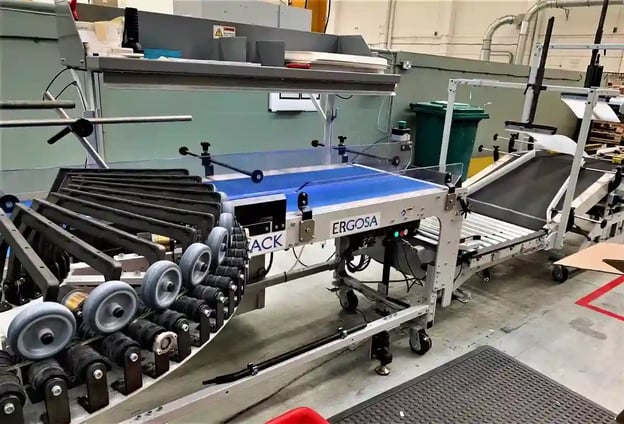
A box turner is a pre-packing device that individually turns each carton box in the shingle* exiting the folder-gluer to form a new shingle with the boxes presented in the desired direction.
Box turners can range from the most basic to the most advanced systems on the market depending on the technology used and the capabilities that these technologies offer.
Being a pre-packer, a box turner is installed right after the folder-gluer and before a packer.
The image below shows where a box turner (a pre-packer) would be located within the flow of your packaging equipment.

If you’re not familiar with what a box turner is, learn here about what a box turner is, how it works, and the benefits it offers to your packing process.
Anyone that owns a folder-gluer packer or stacker needs a box turner.
The only exception is if you own IMPACK’s Ergosa A packer which already includes an IN2 or INH box turner as part of the Ergosa package.
The best choice of a box turner always depends on your box sizes, product mix, format restrictions, and the amount of floor space you have available.
In other words, they are entirely dependent on the folder-gluer packer or stacker you select.
🔍 Related: Ergosa Vs. Virtuo Vs. Everio: Which Folder-Gluer Packer/Stacker Should You Choose?
The working principles of a box turner vary based on the type of box turning technology used.
There are 6 common box turning technologies on the market. Those are:
The simplest and most basic box turning technology that exists on the market is “Basic Tooling on a Folder-Gluer.”
This just means using guides and tools directly on the folder-gluer’s compression belt.
Despite being the most economical way of turning boxes, it is the technology that is most complex to set up and is rather limited in the scope of its application.
In terms of box turner products, IMPACK’s IN1 Box Turner would arguably fall into this box turning technology category: Basic Tooling on a Folder-Gluer.
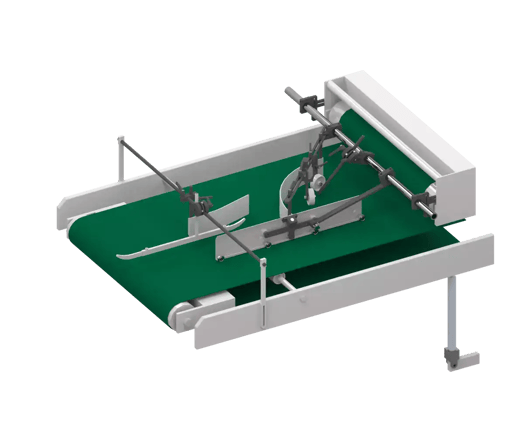
That is to say, the IN1 Box Turner was built as a standardized solution that offers the same capabilities as that of guides and tools used on a folder-gluer’s compression belt.
The IN1 can be installed directly on your folder-gluer’s compression belt and offers you the capability to turn your boxes 90° to the left, 90° to the right, or straight through.
It is the easiest, simplest, and most economical solution on the market to turn your boxes and it offers several possible orientations.
🔍 Learn more here about the IN1 Box Turner.
A “Helicoidal Turner” is one of the most common box turning technologies that exist on the market.
Helicoidal Turners are included in every Collecting Table out there.
Some examples of Collecting Tables that include a Helicoidal Turner are Bobst’s Handypack GT, KBA Duran's Omega Pack Station and Tünkers' FAS 480.
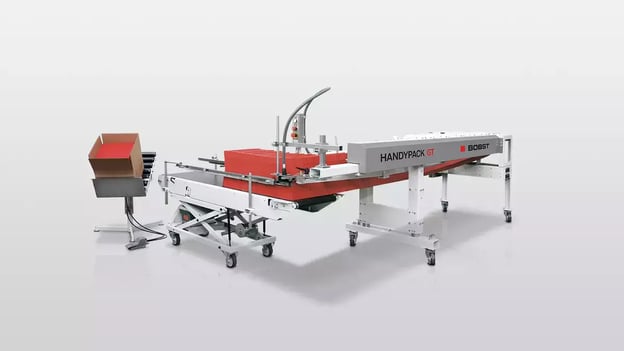
Helicoidal Turners are a fairly economical way of turning kicker boxes on their edge and they have the advantage of keeping the count from the folder-gluer kicker (i.e. keeping the offset box visible throughout the whole turning process).
That said, Helicoidal Turners have the disadvantage of being angled 90° relative to the folder-gluer.
This means that all the equipment following the folder-gluer must be positioned sideways which occupies more floor space.
In addition, with the Helicoidal Turner, the helicoidal turn is mandatory in the sense that there is no straight through mode.
This means that you cannot turn left one day and right the next day; you only get to choose one fixed turning side when purchasing a Helicoidal Turner.
More specifically, it is not possible for your boxes to pass straight through without turning unlike with other box turners such as Basic Tooling on a Folder-Gluer, Turning Tables, Right Angle Transfer Conveyors, or Shingle Turners.
If turning is not required (turning is not required for non-straight line boxes), the Helicoidal Turner must be removed from your production line as it becomes useless and you cannot make use of its accumulation conveyor either.
Learn in this article about the advantages of an accumulation conveyor and how Collecting Tables compare to Semi-Automatic Packers.
A “Turning Table” is also a relatively widespread box turning technology that is popular in the North American market.
WSI Global's MITT Packing Station is an example of one of the popular Turning Tables in Western countries.
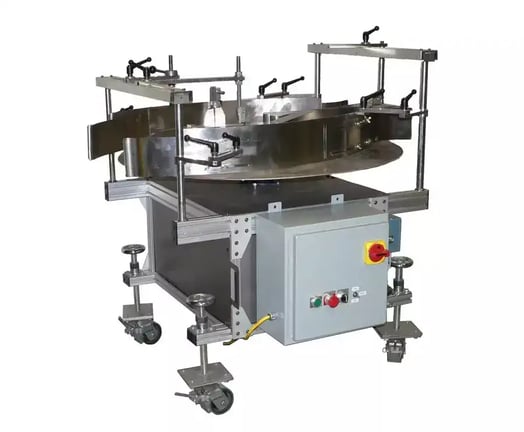
Turning Tables consist of a rotating table and they have the advantage of being compact.
Just like Basic Tooling on a Folder-Gluer, Right Angle Transfer Conveyors, and Shingle Turners, Turning Tables can also turn your boxes 90° to the left, or 90° to the right, depending on the direction of rotation of the table. But there is no straight through mode available.
Turning Tables are generally difficult to set up and it’s hard to get a consistent shingle out of the turn when the folder-gluer speed increases or decreases.
A “Right Angle Transfer Conveyor” is a conveyor positioned perpendicular to an upstream infeed conveyor.
A Right Angle Transfer Conveyor’s process consists of dropping the box shingle onto a conveyor that is positioned slightly underneath the conveyor and at a right angle.
Admittedly, and just like every other box turning technology, this process has its drawbacks. One of these drawbacks, in particular, cannot be overlooked:
If the boxes are counted using the folder-gluer’s kicker, the offset box will be realigned in the turned shingle causing a very slight difference in the shingle pitch* on each side of the counted box.
This means that the count will be difficult to detect by your packing person(s).
The good news is that there are various ways to address this problem and different companies will propose distinct solutions based on your needs and their capabilities.
At IMPACK, we separate those solutions into two types: Marking devices and automatic counting and separation units.
Marking Device: IMPACK’s OBP or OBS systems apply a small amount of diluted optical brightener on the edge of the kicked cartons at the folder-gluer trombone.
This optical brightener, used originally to bleach the carton, has the property of an invisible ink under normal light and glows under blacklights.
We then add a "blacklight led array" at the operating station to make this mark easily visible to your packing person(s).
The picture below from one of our clients depicts this procedure:
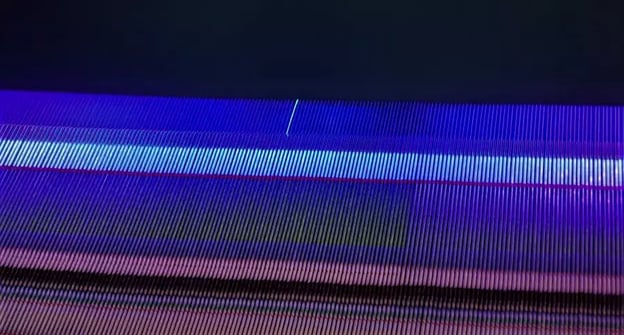
Counting and Separating device: Alternatively, you can add a counting and separating device such as IMPACK’s INTRO.
IMPACK’s INTRO unit uses laser counting and belt separation technology which is present in all IMPACK's Automatic and Fully-Automatic packers and stackers.
Due to high demand from clients, we also made the Counting and Separating device available as a standalone machine that can be paired with our Semi-Automatic packers.
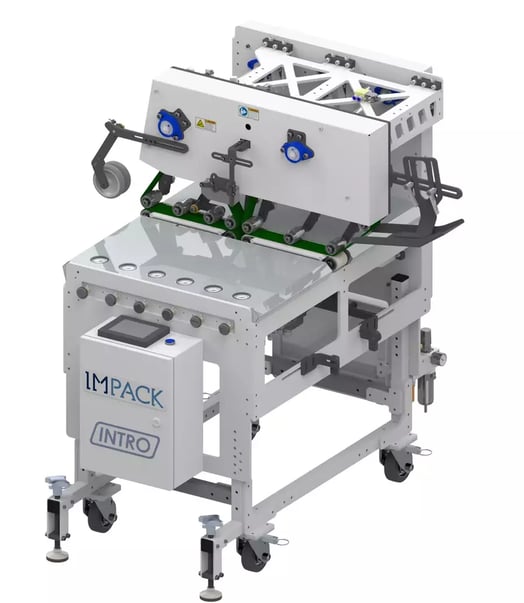
Bobst's CartonPack 4 uses this laser counting technology to count boxes after the Right Angle Transfer Conveyor.
And this same Right Angle Transfer technology is also part of many of IMPACK’s box turners.
If you only have a Right Angle Transfer Conveyor and nothing else, all the equipment following the Right Angle Transfer Conveyor will be positioned sideways which occupies more floor space — just like with the Helicoidal Turners.
You cannot have any other orientation or change this orientation with a Right Angle Transfer Conveyor.
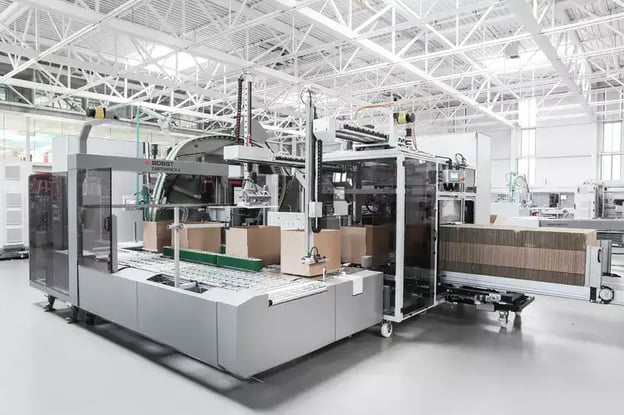
If a semi-circular roller conveyor is installed prior to the Right Angle Transfer Conveyor, then you can change the orientation of your box shingle and keep the downstream equipment aligned with your folder-gluer.
In other words, installing a semi-circular roller conveyor before the Right Angle Transfer Conveyor gives you the flexibility to change the orientation of the equipment following the folder-gluer and you’re no longer stuck with your equipment being fixed sideways after your folder-gluer.
Some examples of machines that have a Right Angle Transfer Conveyor and a semi-circular roller conveyor combination are Graphic West’s J-Pack, KBA Duran's Omega Pack Station, and Heidelberg’s Diana Packer.
As well as IMPACK’s IN2 Box Turners.
The integration of those rollers allows different orientations (90° to the left, 90° to the right, or straight through) but they require you to move the downstream equipment sideways to achieve the desired orientation.
🔍 Learn more here about the IN2 Box Turner.
There are also other types of box turning technologies that change the orientation of the shingle altogether instead of turning each box individually within the shingle.
These box turners are called “Shingle Turners.”
Shingle Turners are normally used to change the direction of the flow of boxes to allow you to install your packing system either parallel to the folder-gluer (on its side) or on its perpendicular axis. This is convenient when there is limited space after the folder-gluer.
IMPACK’s Shingle Turners are the IN2C Shingle and Box Turner and the INU Shingle Turner.
1. IN2C Shingle and Box Turner: This unit offers two turning modes:
2. INU Shingle Turner: The “U” in the INU Shingle Turner refers to the U-turn capability of the INU Shingle Turner which is different from the 180° turn offered by the IN180 Box Turner.
The picture below shows a side-by-side comparison of the INU Shingle Turner and the IN180 Box Turner.
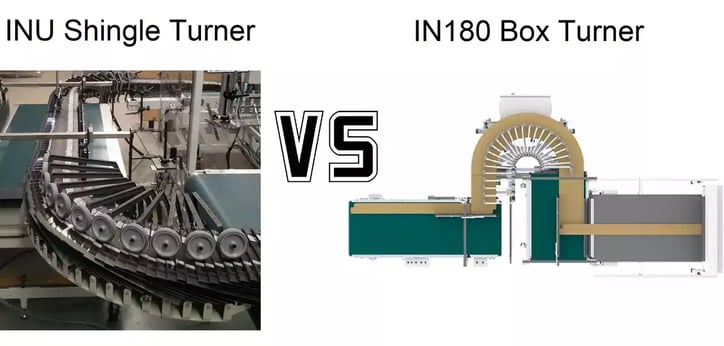
The INU Shingle Turner can be installed at the end of a folder-gluer to have the shingle turned 180° in parallel to the folder-gluer. This enables you to use that extra space for a packer or stacker.
This means that the packer is oriented towards the feeder of the folder-gluer. So the palletizing will take place at the beginning of your folder-gluer.
🔍 Learn more here about the IN2C Shingle and Box Turner.
🔍 Learn more here about the INU Shingle Turner.
There are also other “combinations” or hybrids of the above box turning technologies that are available on the market.
Those hybrids combine several of the features and capabilities offered by each of the individual box turning technologies to provide more benefits within one box turning technology.
Listed below are a few examples of combinations that we designed here at IMPACK:
1. Our IN3 Box Turner (patented) combines a Right Angle Transfer Conveyor with multiple sets of rollers and an extensible belt to provide all 3 orientations (90° to the left, 90° to the right, or straight through).
The best part about the IN3 is that you do not need to move any of your downstream equipment since the shingle remains in the same center axis position no matter which turning mode is used (even when using the straight through mode).
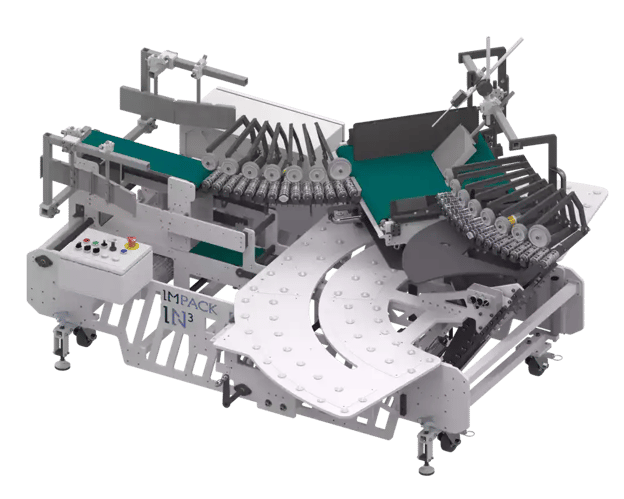
🔍 Learn more here about the IN3 Box Turner.
2. Our IN180 Box Turner combines two Right Angle Transfer sections with multiple sets of rollers and belts to provide a straight through path or a 180° turn.
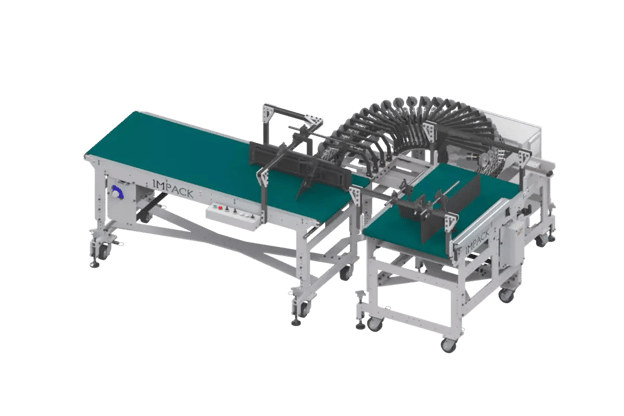
🔍 Learn more here about the IN180 Box Turner.
Our INH Box Turner is our newest innovation with the most advanced box turning technology on the market (patent pending).
As illustrated in the image below, the INH turns the box shingle and makes the boxes stand on their folded edge in the gluing direction. All in one single motion.
The INH Box Turner is a unique combination of a roller section shaped in a helicoidal path and an accumulation conveyor that is oriented in the gluing direction.
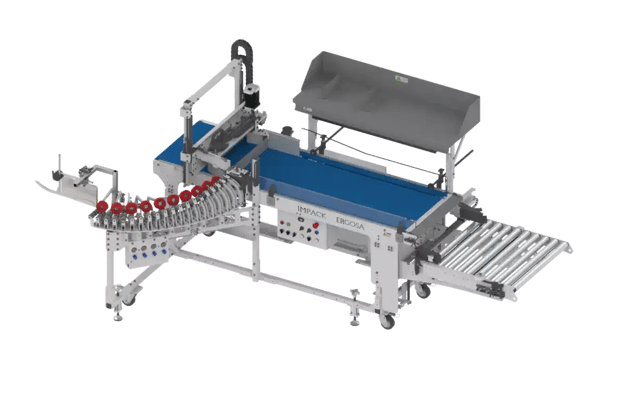
Thus, the INH Box Turner occupies far less floor space than the Helicoidal Turners (Helicoidal turners are the box turning technologies used in Collecting Tables such as Bobst’s Handypack GT, KBA Duran's Omega Pack Station and Tünkers' FAS 480).
🔍 Learn more here about the INH Box Turner.
.webp?width=624&name=ezgif.com-gif-maker%20(58).webp)
Now that you have a very good understanding of the top 6 box turning technologies, and their differences, your next step would be to choose the best box turner product for your production.
We talked about several of IMPACK’s Box Turner products and what box turning technologies they use.
You’re probably asking yourself: “How do those box turner options compare against each other?”
Well, we’ve got you covered!
Begin by comparing IMPACK’s Box Turners side-by-side by reading “Comparing IMPACK’s Box Turners: Which Is Best For Your Company?”
Learn more about the specifications of IMPACK’s Box Turners by visiting “IMPACK’s Box Turners”
Find out how to choose the best box turner for your company by checking out "What Box Turner Is Right For You?"
We’d love to help! Contact us today if you’ve got more questions.
IMPACK’s experts would love to help and maybe even show you some of our box turners LIVE on a video call 😉.
.jpg)
If you’re considering the purchase of Impack packaging's Ergosa packer, you’re probably debating what Box Turner you should choose to be paired with...
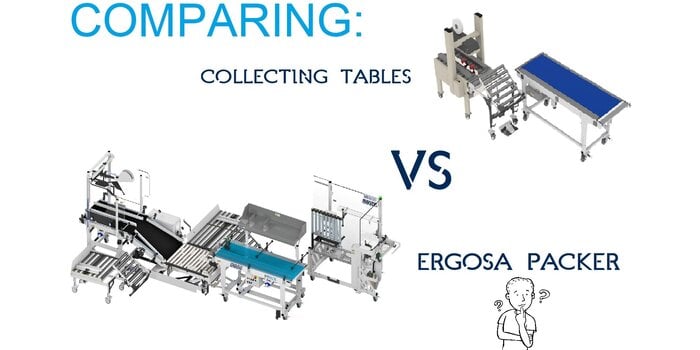
Let’s address the elephant in the room that most packaging producers avoid talking about :
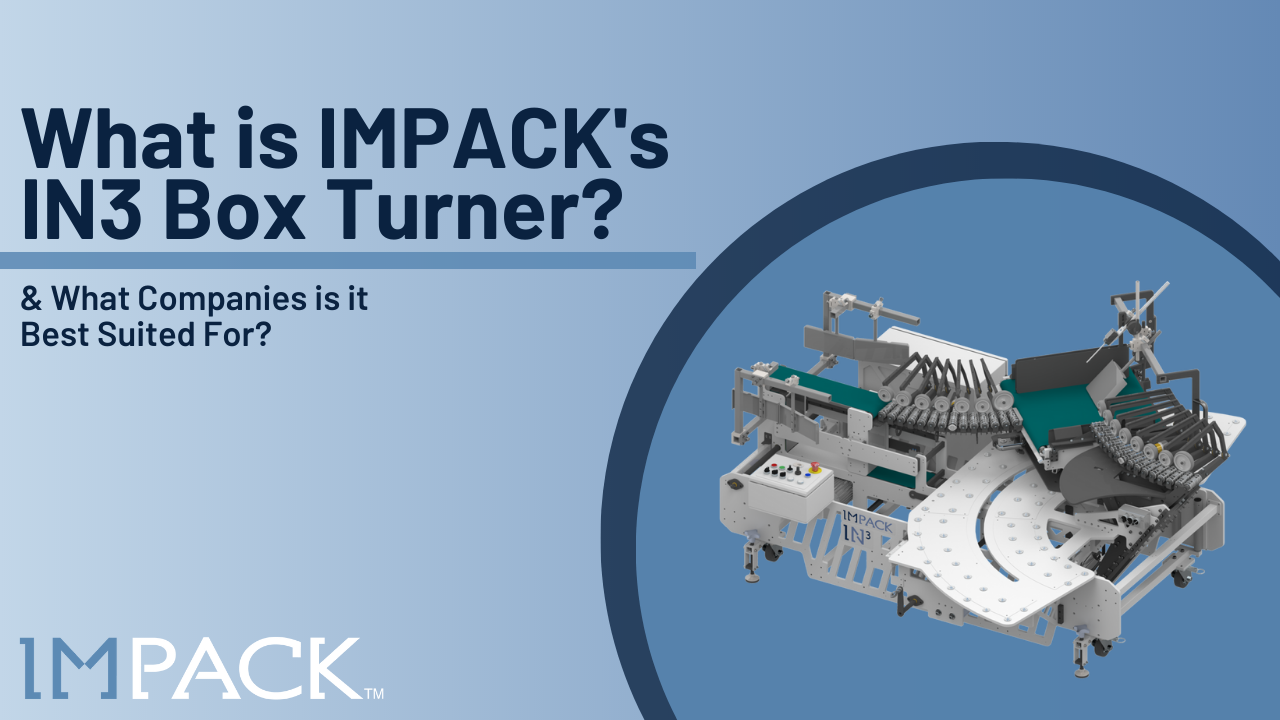
Are you searching for ways to improve your folder-gluer productivity and reach higher packing speeds?